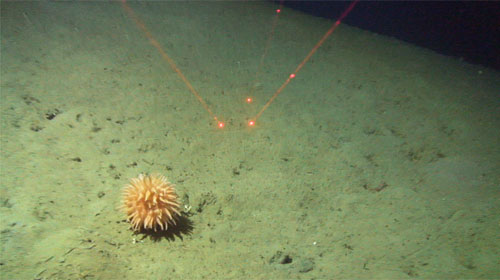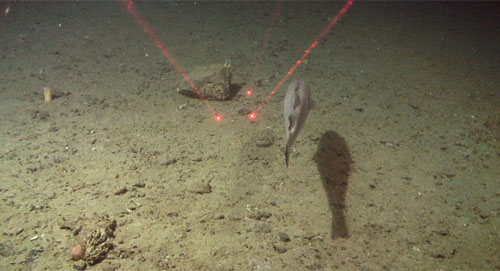
Contact
Cruise leader/biology
Lis Lindal Jørgensen
Geology
Reidulv Bøe
Chemistry
Stepan Boitsov
Communication advisor
Beate Hoddevik Sunnset
+47 55 23 85 16
+47 908 21 630

Published: 14.08.2013 Updated: 24.10.2019
The cruise has been particularly successful with respect to sediment sampling for geochemical analyses. Sediment cores of 30-40 cm length were collected at 9 locations, as shown in Figure 1.

Figure 1. Sampling locations in the Barents Sea. Red circles show locations where samples for geochemical analysis were collected by means of multicorer. Yellow circles show locations where seabed conditions did not allow sediment sampling by multicorer, while the white dots show locations where the seabed was mapped by video only. The coast of the Varanger Peninsula is shown in grey colour at the bottom left. The sea depths in the mapped area vary from approximately 200 m, shown in green, to approximately 350 m, in blue colour.
Extensive sampling was possible because of fine-grained sediments over much of the area (Figure 2). The multicorer provides sediment cores of high quality in muddy sediments. Fine-grained sediments are suited for chemical analysis of contaminants, since they are rich in organic material to which contaminants may be bound.

Figure 2. Multicorer is only used where the seabed is covered by fine-grained sediments. This is checked by various analyses in advance. The picture shows a soft sediment seabed well suited for multicorer sampling.
Coarse sediments with high sand contents contain less organic material and are therefore not suitable for environmental monitoring. Such sediments also give erroneous environmental monitoring results. At some localities (mostly at topographic heights) multicorer sampling was not attempted due to pebbles, cobbles and boulders on the seabed (Figure 3).

Figure 3. Hard seabed with cobbles and boulders, such as here, are not suited for multicorer sampling.
Sediment cores obtained were cut into 1cm thick slices and frozen onboard immediately after sampling. The samples will be analyzed for organic contaminants (hydrocarbons, brominated flame retardants) and radioactive elements (to check the degree of radioactive pollution and to date the sediments) at IMR. The results of these measurements will be ready during the autumn 2014. NGU will analyze the content of inorganic contaminants, carbon and sulphur, as well as various sediment properties.
The collected samples and geochemical results will provide new knowledge on the environmental condition in this part of the Barents Sea, which has not previously been part of Norwegian monitoring programs.